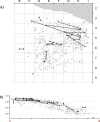No Reliable Evidence for a Neanderthal-Châtelperronian Association at La Roche-à-Pierrot, Saint-Césaire
- PMID: 30310091
- PMCID: PMC6181958
- DOI: 10.1038/s41598-018-33084-9
No Reliable Evidence for a Neanderthal-Châtelperronian Association at La Roche-à-Pierrot, Saint-Césaire
Abstract
The demise of Neanderthals and their interaction with dispersing anatomically modern human populations remain some of the most contentious issues in palaeoanthropology. The Châtelperronian, now generally recognized as the first genuine Upper Palaeolithic industry in Western Europe and commonly attributed to the Neanderthals, plays a pivotal role in these debates. The Neanderthal authorship of this techno-complex is based on reported associations of Neanderthal skeletal material with Châtelperronian assemblages at only two sites, La Roche-à-Pierrot (Saint-Césaire) and the Grotte du Renne (Arcy-sur-Cure). The reliability of such an association has, however, been the subject of heated controversy. Here we present a detailed taphonomic, spatial and typo-technological reassessment of the level (EJOP sup) containing the Neanderthal skeletal material at Saint-Césaire. Our assessment of a new larger sample of lithic artifacts, combined with a systematic refitting program and spatial projections of diagnostic artifacts, produced no reliable evidence for a Neanderthal-Châtelperronian association at the site. These results significantly impact current models concerning the Middle-to-Upper Palaeolithic transition in Western Europe and force a critical reappraisal of who exactly were the makers of the Châtelperronian.
Conflict of interest statement
The authors declare no competing interests.
Figures







References
Publication types
MeSH terms
LinkOut - more resources
Full Text Sources

